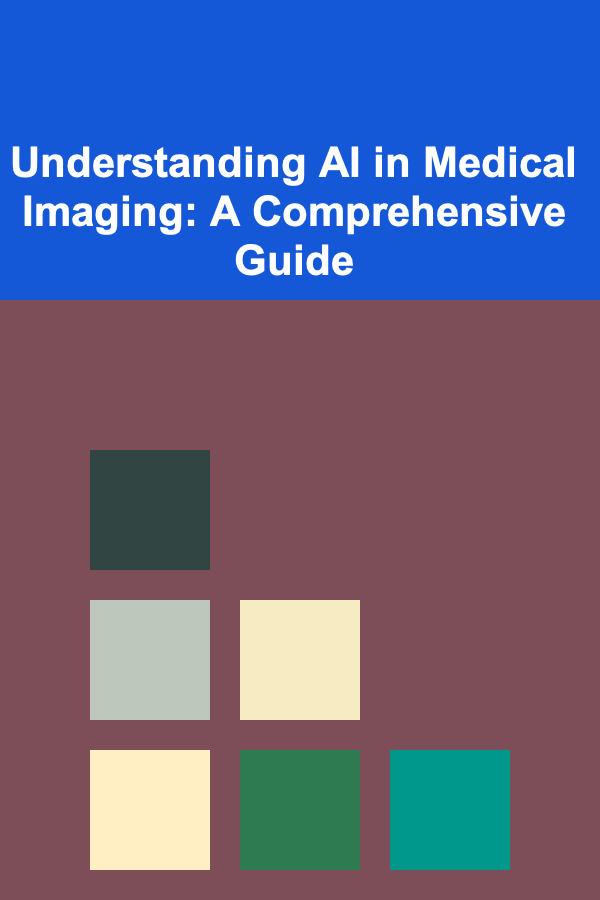
Understanding AI in Medical Imaging: A Comprehensive Guide
ebook include PDF & Audio bundle (Micro Guide)
$12.99$6.99
Limited Time Offer! Order within the next:

Artificial intelligence (AI) is rapidly transforming healthcare, and medical imaging is at the forefront of this revolution. From detecting subtle anomalies to accelerating diagnosis, AI-powered tools are poised to enhance the capabilities of radiologists and other healthcare professionals. However, understanding the nuances of AI in medical imaging is crucial for effective implementation and responsible use. This article provides a comprehensive overview of the field, covering the fundamental concepts, techniques, applications, challenges, and future directions.
Introduction to AI and Medical Imaging
Medical imaging encompasses various techniques used to visualize the internal structures of the body for diagnostic and therapeutic purposes. Common modalities include:
- X-ray: Uses electromagnetic radiation to create images of bones and dense tissues.
- Computed Tomography (CT): Combines multiple X-ray images taken from different angles to create cross-sectional images.
- Magnetic Resonance Imaging (MRI): Uses strong magnetic fields and radio waves to create detailed images of soft tissues, organs, and bones.
- Ultrasound: Uses high-frequency sound waves to create real-time images of organs and tissues.
- Nuclear Medicine (e.g., PET, SPECT): Uses radioactive tracers to visualize physiological processes and detect abnormalities.
The interpretation of medical images can be time-consuming and subjective, potentially leading to diagnostic errors or delays. AI, particularly machine learning (ML) and deep learning (DL), offers the potential to automate and augment the analysis of medical images, improving accuracy, efficiency, and consistency.
Core Concepts of AI in Medical Imaging
2.1 Machine Learning (ML)
Machine learning is a branch of AI that enables systems to learn from data without being explicitly programmed. ML algorithms can identify patterns, make predictions, and improve their performance over time as they are exposed to more data. In medical imaging, ML can be used for tasks such as:
- Image classification: Identifying whether an image contains a specific disease or condition (e.g., pneumonia, cancer).
- Object detection: Locating and identifying specific objects within an image (e.g., nodules in the lungs, fractures in bones).
- Image segmentation: Partitioning an image into different regions or objects of interest (e.g., segmenting organs, tumors).
- Image registration: Aligning images from different modalities or time points.
Common ML algorithms used in medical imaging include:
- Support Vector Machines (SVMs): Effective for classification and regression tasks, particularly with high-dimensional data.
- Random Forests: Ensemble learning method that combines multiple decision trees for improved accuracy and robustness.
- K-Nearest Neighbors (KNN): Simple and intuitive algorithm that classifies data points based on the majority class of their nearest neighbors.
- Logistic Regression: A statistical method for predicting the probability of a binary outcome (e.g., presence or absence of a disease).
2.2 Deep Learning (DL)
Deep learning is a subfield of machine learning that uses artificial neural networks with multiple layers (hence "deep") to extract complex features from data. Deep learning models have achieved remarkable success in various tasks, including image recognition, natural language processing, and speech recognition. In medical imaging, DL has demonstrated state-of-the-art performance in tasks such as:
- Automated diagnosis: Detecting diseases with accuracy comparable to or exceeding human experts.
- Precise segmentation: Delineating anatomical structures with high precision, enabling accurate measurements and volumetry.
- Image enhancement: Improving the quality of images, reducing noise, and enhancing contrast.
- Image reconstruction: Creating images from incomplete or noisy data.
Key deep learning architectures used in medical imaging include:
- Convolutional Neural Networks (CNNs): Designed to process grid-like data, such as images, by learning spatial hierarchies of features. CNNs are widely used for image classification, object detection, and segmentation. Examples include AlexNet, VGGNet, ResNet, and U-Net.
- Recurrent Neural Networks (RNNs): Designed to process sequential data, such as time-series data or video. RNNs can be used for tasks such as analyzing cardiac motion or predicting disease progression. Long Short-Term Memory (LSTM) networks are a common type of RNN.
- Generative Adversarial Networks (GANs): Consist of two neural networks, a generator and a discriminator, that are trained in an adversarial manner. GANs can be used for image generation, image enhancement, and data augmentation.
2.3 Key Differences Between ML and DL
While deep learning is a subset of machine learning, there are key differences that impact their application in medical imaging:
- Feature Extraction: Traditional ML algorithms typically require manual feature engineering, where domain experts carefully select and extract relevant features from the images. Deep learning models, on the other hand, can automatically learn features from raw data, reducing the need for manual feature engineering.
- Data Requirements: Deep learning models typically require much larger datasets than traditional ML algorithms to achieve good performance. This is because they have many more parameters to learn.
- Computational Resources: Deep learning models are computationally intensive and require powerful hardware, such as GPUs, for training.
- Interpretability: Deep learning models are often considered "black boxes" because it can be difficult to understand how they arrive at their predictions. This lack of interpretability can be a concern in medical applications, where it is important to understand the reasoning behind a diagnosis or treatment recommendation. However, research is ongoing to improve the interpretability of deep learning models.
Applications of AI in Medical Imaging
AI is being applied to a wide range of medical imaging tasks across different modalities and clinical areas. Here are some prominent examples:
3.1 Radiology
- Lung Nodule Detection and Characterization: AI can assist radiologists in detecting small lung nodules on CT scans, which can be indicative of lung cancer. It can also help characterize nodules based on their size, shape, and density, aiding in determining whether they are likely to be benign or malignant.
- Breast Cancer Screening: AI can analyze mammograms to detect suspicious lesions and reduce false positive rates, leading to earlier detection of breast cancer. It can also be used to assess breast density, a known risk factor for breast cancer.
- Stroke Detection and Management: AI can analyze CT scans to identify signs of stroke, such as hemorrhage or ischemia. It can also help quantify the extent of the damage and guide treatment decisions.
- Bone Fracture Detection: AI algorithms can quickly scan X-ray images to identify fractures, helping emergency room physicians speed up diagnosis and treatment.
3.2 Cardiology
- Cardiac Segmentation and Measurement: AI can automatically segment the heart chambers and vessels on MRI or CT scans, enabling accurate measurements of cardiac volumes and function.
- Coronary Artery Disease Detection: AI can analyze CT angiograms to detect and quantify the severity of coronary artery disease.
- Arrhythmia Detection: AI can analyze electrocardiograms (ECGs) to detect arrhythmias, such as atrial fibrillation.
3.3 Neurology
- Alzheimer's Disease Detection: AI can analyze brain MRI scans to detect early signs of Alzheimer's disease, such as atrophy of the hippocampus.
- Multiple Sclerosis Detection and Monitoring: AI can analyze brain MRI scans to detect and quantify the number and size of lesions associated with multiple sclerosis.
- Brain Tumor Detection and Segmentation: AI can analyze brain MRI scans to detect and segment brain tumors, aiding in diagnosis and treatment planning.
3.4 Pathology
- Cancer Detection and Grading: AI can analyze digitized pathology slides to detect cancer cells and grade the severity of the disease.
- Image Analysis and Quantification: AI algorithms can quantify various features in pathology images, such as cell counts, protein expression levels, and tissue morphology.
3.5 Interventional Radiology
- Image-Guided Interventions: AI can be used to enhance the visualization and navigation during image-guided interventions, such as biopsies, ablations, and catheterizations.
- Robotics Assistance: AI can be integrated with robotic systems to automate certain aspects of interventional procedures, improving accuracy and efficiency.
The AI Development Pipeline for Medical Imaging
Developing AI solutions for medical imaging involves a structured pipeline, encompassing data acquisition, preparation, model development, validation, and deployment.
4.1 Data Acquisition and Preparation
The quality and quantity of data are critical for training effective AI models. This phase involves:
- Data Collection: Gathering medical images (e.g., CT scans, MRIs, X-rays) from various sources, ensuring diversity in patient demographics, disease stages, and imaging protocols.
- Data Anonymization: Removing Protected Health Information (PHI) to protect patient privacy and comply with regulations like HIPAA.
- Data Labeling: Annotating images with ground truth information, such as disease labels, object locations, and segmentation masks. This is often the most time-consuming and expensive part of the process. Labeling can be done manually by experts, or semi-automatically using existing tools and algorithms.
- Data Augmentation: Increasing the size and diversity of the dataset by applying transformations to existing images, such as rotations, flips, zooms, and contrast adjustments. This helps improve the robustness and generalization ability of the AI model.
- Data Splitting: Dividing the dataset into training, validation, and testing sets. The training set is used to train the AI model, the validation set is used to tune the model's hyperparameters, and the testing set is used to evaluate the model's performance on unseen data.
4.2 Model Development
This phase involves selecting and training an appropriate AI model for the specific task. Key steps include:
- Model Selection: Choosing the appropriate AI architecture based on the task and the characteristics of the data. For example, CNNs are often used for image classification and segmentation, while RNNs may be used for analyzing sequential data.
- Model Training: Feeding the training data into the AI model and adjusting its parameters to minimize the difference between its predictions and the ground truth labels. This process is often iterative and requires careful monitoring of the model's performance on the validation set.
- Hyperparameter Tuning: Optimizing the model's hyperparameters, such as learning rate, batch size, and network architecture, to improve its performance. This can be done manually or automatically using techniques such as grid search or Bayesian optimization.
- Regularization: Using techniques such as dropout or weight decay to prevent overfitting, which occurs when the model learns the training data too well and performs poorly on unseen data.
4.3 Model Validation and Testing
Rigorous validation and testing are essential to ensure the AI model is accurate, reliable, and generalizable.
- Internal Validation: Evaluating the model's performance on the validation set to tune its hyperparameters and identify potential issues.
- External Validation: Evaluating the model's performance on an independent testing set that was not used during training or validation. This provides a more realistic estimate of the model's performance on unseen data.
- Clinical Validation: Assessing the model's performance in a clinical setting, comparing its results to those of human experts, and evaluating its impact on patient outcomes. This is the most important step in the validation process, as it determines whether the model is safe and effective for clinical use.
- Bias Detection and Mitigation: Assessing the model for potential biases that may lead to unfair or inaccurate results for certain patient populations. This is crucial to ensure that AI models are used equitably. Techniques to mitigate bias include using diverse training data, and applying fairness-aware algorithms.
4.4 Model Deployment and Monitoring
Once the model is validated, it can be deployed into clinical practice. This involves:
- Integration with Existing Systems: Integrating the AI model with existing PACS (Picture Archiving and Communication System) or other clinical workflows.
- User Interface Design: Designing a user-friendly interface that allows healthcare professionals to interact with the AI model and interpret its results.
- Continuous Monitoring: Continuously monitoring the model's performance in clinical practice to ensure that it remains accurate and reliable over time. This may involve retraining the model with new data or updating its parameters as needed.
- Explainable AI (XAI): Implementing techniques to make the AI model's decisions more transparent and understandable to healthcare professionals. This can help build trust in the model and facilitate its adoption in clinical practice. Examples include visualizing the areas of the image that the model is focusing on (attention maps), and providing explanations of why the model made a particular prediction.
Challenges and Limitations
Despite the great potential of AI in medical imaging, there are significant challenges and limitations that need to be addressed:
- Data Scarcity and Bias: Medical imaging datasets can be small and biased, leading to models that are not generalizable to diverse patient populations. Access to large, high-quality, and diverse datasets is essential for training robust AI models.
- Data Annotation Costs: Annotating medical images is a time-consuming and expensive process that requires specialized expertise. This can be a major bottleneck in the development of AI solutions.
- Lack of Interpretability: Deep learning models are often "black boxes," making it difficult to understand how they arrive at their predictions. This lack of interpretability can be a concern in medical applications, where it is important to understand the reasoning behind a diagnosis or treatment recommendation.
- Regulatory Hurdles: The regulatory landscape for AI in medical imaging is still evolving. Clear and consistent guidelines are needed to ensure that AI-powered medical devices are safe and effective. Agencies like the FDA are actively working on developing regulatory frameworks for AI in healthcare.
- Ethical Concerns: AI in medical imaging raises ethical concerns related to patient privacy, data security, and the potential for bias and discrimination. It is important to address these concerns proactively to ensure that AI is used responsibly and ethically.
- Integration Challenges: Integrating AI solutions into existing clinical workflows can be challenging. Healthcare professionals need to be trained on how to use AI tools effectively and interpret their results. Workflow changes and potential disruptions need to be carefully managed.
- Adversarial Attacks: AI systems can be vulnerable to adversarial attacks, where subtle modifications to the input image can cause the model to make incorrect predictions. Ensuring the robustness of AI models against adversarial attacks is critical for safety.
- Generalizability Across Institutions and Equipment: AI models trained on data from one institution or using a specific type of equipment may not perform well on data from other institutions or using different equipment. Developing models that are generalizable across different settings is an ongoing challenge.
The Future of AI in Medical Imaging
The future of AI in medical imaging is bright, with ongoing research and development pushing the boundaries of what is possible. Here are some key trends and future directions:
- Federated Learning: This approach allows AI models to be trained on decentralized data sources without sharing the data itself. This can help address data scarcity and privacy concerns.
- Self-Supervised Learning: This approach allows AI models to learn from unlabeled data, reducing the need for expensive data annotation.
- Explainable AI (XAI): Continued advancements in XAI will make AI models more transparent and understandable, fostering trust and adoption in clinical practice.
- Multi-Modal AI: Integrating information from multiple imaging modalities (e.g., CT, MRI, PET) and other data sources (e.g., clinical history, genomics) to create more comprehensive and accurate diagnostic tools.
- AI-Powered Robotics: Combining AI with robotics to automate and improve the precision of interventional procedures.
- Personalized Medicine: Using AI to tailor treatment plans to individual patients based on their unique characteristics and imaging findings.
- Continuous Learning and Adaptation: Developing AI models that can continuously learn and adapt to new data and evolving clinical practices.
- Edge Computing: Deploying AI models on edge devices (e.g., imaging scanners) to enable real-time analysis and reduce the need for cloud computing.
- Increased Automation of Reporting: AI systems will increasingly automate the generation of preliminary radiology reports, freeing up radiologists to focus on more complex cases.
- Integration with Augmented Reality (AR): Combining AI-powered image analysis with AR to provide surgeons with real-time guidance during surgery.
Conclusion
AI is poised to revolutionize medical imaging, offering the potential to improve accuracy, efficiency, and patient outcomes. By understanding the fundamental concepts, techniques, applications, challenges, and future directions of AI in medical imaging, healthcare professionals can effectively leverage these tools to enhance their clinical practice and provide better care for their patients. It is crucial to approach the implementation of AI in medical imaging with a focus on data quality, ethical considerations, and continuous monitoring to ensure that these powerful technologies are used responsibly and effectively.
Reading More From Our Other Websites
- [Organization Tip 101] How to Use a Whiteboard for Weekly Meal Planning
- [Organization Tip 101] How to Use Labels to Keep Your Bathroom Organized
- [Hiking with Kids Tip 101] Kid-Friendly Trail Snacks That Keep Energy Up and Mess Down
- [Organization Tip 101] How to Design a Volunteer Handbook for Orientation
- [Home Budget 101] How to Create a Realistic Home Budget That You Can Stick To
- [Organization Tip 101] Why Regular Maintenance Keeps Your Home Organized
- [Personal Care Tips 101] How to Find the Best Body Lotion for Your Morning Routine
- [Home Holiday Decoration 101] How to Incorporate Vintage Decorations into Modern Holiday Designs
- [Organization Tip 101] Best Organization Tools for Managing Books and Reading
- [Organization Tip 101] How to Create a Functional Entryway: Tips and Tricks

How to Handle Tenant Complaints and Disputes Professionally
Read More
How to Use Baskets for Clutter-Free Entryway Organization
Read More
How to Use Vertical Space for Dining Room Storage
Read More
Why You Should Involve Children in Organizing Their Spaces
Read More
How To Understand the Legal Aspects of Running a POD Business
Read More
How to Buy Your First Stock
Read MoreOther Products

How to Handle Tenant Complaints and Disputes Professionally
Read More
How to Use Baskets for Clutter-Free Entryway Organization
Read More
How to Use Vertical Space for Dining Room Storage
Read More
Why You Should Involve Children in Organizing Their Spaces
Read More
How To Understand the Legal Aspects of Running a POD Business
Read More